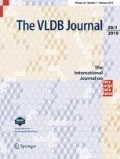Abstract.
As no database exists without indexes, no index implementation exists without order-preserving key compression, in particular, without prefix and tail compression. However, despite the great potentials of making indexes smaller and faster, application of general compression methods to ordered data sets has advanced very little. This paper demonstrates that the fast dictionary-based methods can be applied to order-preserving compression almost with the same freedom as in the general case. The proposed new technology has the same speed and a compression rate only marginally lower than the traditional order-indifferent dictionary encoding. Procedures for encoding and generating the encode tables are described covering such order-related features as ordered data set restrictions, sensitivity and insensitivity to a character position, and one-symbol encoding of each frequent trailing character sequence. The experimental results presented demonstrate five-folded compression on real-life data sets and twelve-folded compression on Wisconsin benchmark text fields.
Similar content being viewed by others
Author information
Authors and Affiliations
Additional information
Edited by M.T. Ozsu. Received 1 February 1995 / Accepted 1 November 1995
Rights and permissions
About this article
Cite this article
Antoshenkov, G. Dictionary-based order-preserving string compression . The VLDB Journal 6, 26–39 (1997). https://doi.org/10.1007/s007780050031
Issue Date:
DOI: https://doi.org/10.1007/s007780050031




